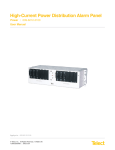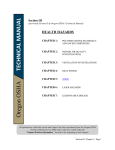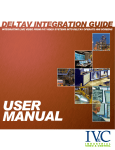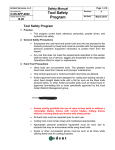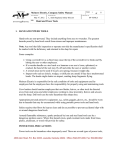Download Electric Portable Power Tool Safety
Transcript
Electric Portable Power Tool Safety It is likely that most people were first exposed to portable power tools at an early age. They watched others use the tool until they were called upon to help in a project. The primary objective was to get the job done. Safety and training may have been secondary or nonexistent to that first-time tool user. They may have learned to use the tool in a safe manner only after incurring a near accident or bodily injury. Also, some new employees may not have previously used the tool(s) that are required to perform their job. It is a good practice to ask new employees about their previous experience with each tool they will use and determine if they know how to use them safely. If there is any doubt regarding their ability to do so, training should be conducted. • Never leave a power tool unattended in a place where unauthorized people could attempt to operate it. Only trained operators should use power tools. Safe Tool Operations • Never yank the cord or hose from the receptacle to disconnect. • Use the proper tool for the job. For power tools, follow the manufacturer’s recommended usage. • Keep the tools in good operating condition. The operator should inspect the tool prior to use and should not knowingly use a tool in poor condition. • If a central tool crib exists within the organization, the attendant should inspect each tool as it is returned. Any tool in poor condition should be repaired or replaced. The tool crib attendant should also inspect the condition of fasteners when a new tool is received from a vendor. • Do not remove, reposition or tamper with safety guards provided by the manufacturer. Guards should only be removed to clean, repair or replace component parts. When the guard is removed for those reasons, disconnect the power source first. • Keep tools in a safe and proper place. Tools and power cords should not be left on the floor where they present a trip hazard. Tools used in overhead areas should have a safety line attached to prevent them from falling on people below. • Store tools in a dry place when not in use. • Do not use electric tools in damp or wet locations. • Never carry a tool by the cord or hose. • Keep cords and hoses away from heat, oil and sharp edges. • Disconnect tools when not in use, before servicing and when changing accessories such as blades, bits and cutters. • Keep all observers at a safe distance from the work area. • Secure work with clamps or a vise, freeing both hands to operate the tool. • Avoid accidental starting. Do not hold fingers on the switch button while carrying a plugged-in tool. • Maintain tools with care. Follow instructions in the user’s manual for lubricating and changing accessories. • Be sure to maintain solid footing and good balance when using tools. Continued www.emcins.com Electric Portable Power Tool Safety • Remove all damaged portable electric tools from use and tag them “Do Not Use.” • Do not operate equipment with damaged cords. • Wear the proper safety equipment for protection when working with tools. Personal Protective Equipment Work Condition Safety Goggles Anytime a particle could fall of fly into eyes. Face Shields Using grinders, buffing wheels, etc. Safety Shoes If tool or work could fall on the foot. Hearing Protection Using rotary cutting tools, jackhammers, etc. Hair Restraint Using rotary tools such as drills, saws, grinders, etc. DO NOT wear gloves, ties, or loose clothing or jewelry Using rotary tools such as drills, saws, grinders, etc. Electrical Hazards Employees using electric tools should be aware of several dangers, the most serious being electrocution. Burns and slight shocks, which can lead to injuries or even heart failure, are among the major hazards associated with electric power tools. Under certain conditions, even a small amount of current can result in fibrillation of the heart and eventual death. A shock also can cause the user to fall off a ladder or other elevated work surface. To protect the user from shock, tools should have either of the following: a three-wire cord with ground and be grounded or be double insulated. Three-wire cords contain two current-carrying conductors and a grounding conductor. One end of the grounding conductor connects to the tool’s metal housing. The other end is grounded through a prong on the plug. Anytime an adapter is used to accommodate a twohole receptacle, the adapter wire should be attached to a known ground. The third prong should never be removed from the plug. Double insulation is the more convenient of the two methods. The user and the tools are protected in two ways: by normal insulation on the wires inside and by a housing that cannot conduct electricity to the operator in the event of a malfunction. To protect against electrical shock hazards, the U.S. Consumer Product Safety Commission recommends the use of a ground-fault circuit-interrupter (GFCI) with every power tool. A GFCI constantly monitors current flowing into a circuit to sense any loss of current. If the current flowing through two circuit conductors differs by a very small amount, the GFCI instantly interrupts the current flow to prevent a lethal amount of electricity from reaching the operator. The operator may feel a painful shock, but will not be electrocuted. Most of the 20-30 electrocution deaths each year associated with power drills, saws, sanders, hedge trimmers and other electric power tools could have been prevented if a GFCI had been used. For Additional Information Occupational Safety & Health Administration: www.osha.gov • Construction eTool • Hand and Power Tools Consumer Product Safety Commission: www.cpsc.gov EMC Loss Prevention Information Manual: www.emcins.com • Hand Tools Home Office: 717 Mulberry • Des Moines, IA 50309 • 800-447-2295 • www.emcins.com Disclaimer: This material is designed and intended for general information purposes only, and is not intended, nor shall be construed or relied upon, as specific legal advice. ©Copyright Employers Mutual Casualty Company 2011. All rights reserved. Image ©2010 JupiterImages Corporation. 6183 (9-11)


